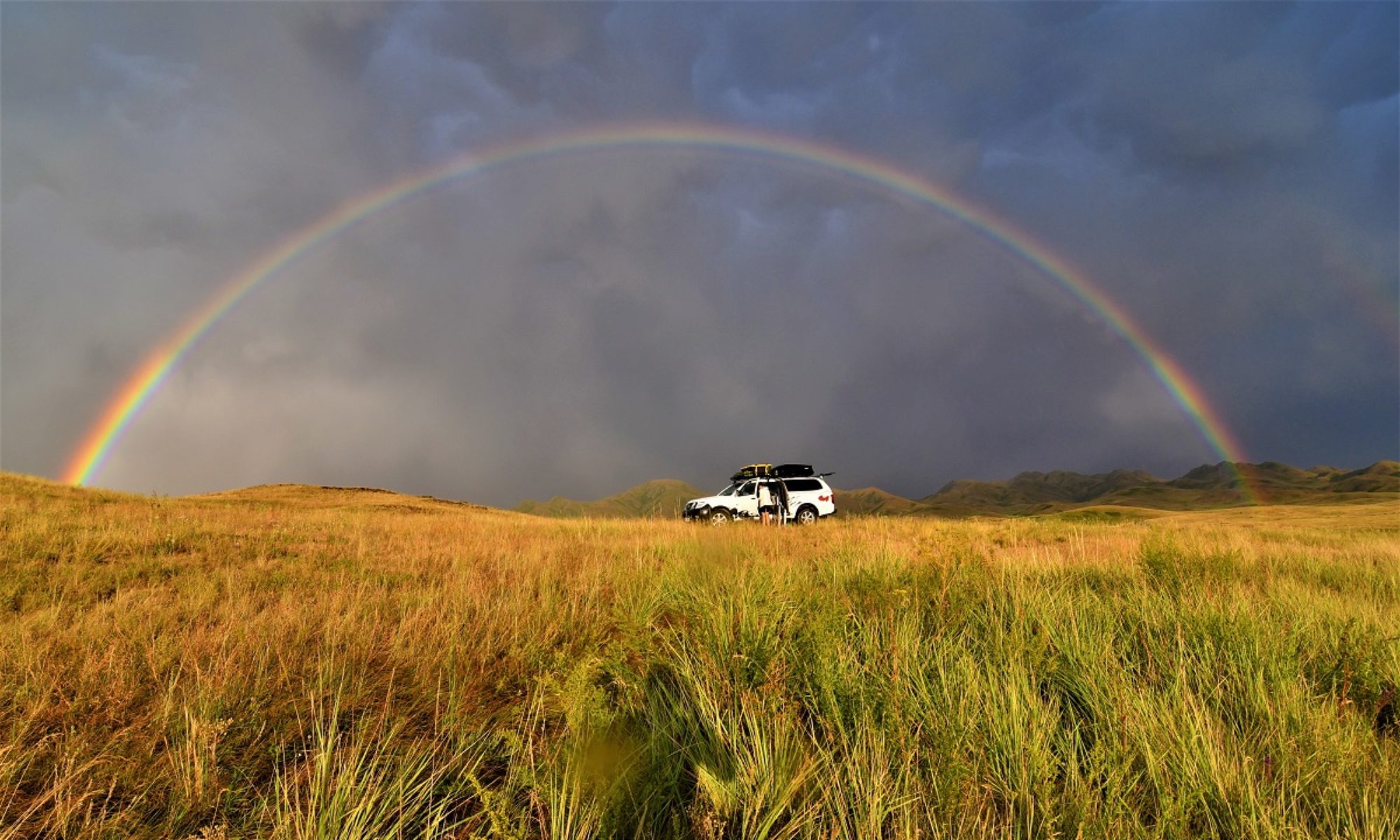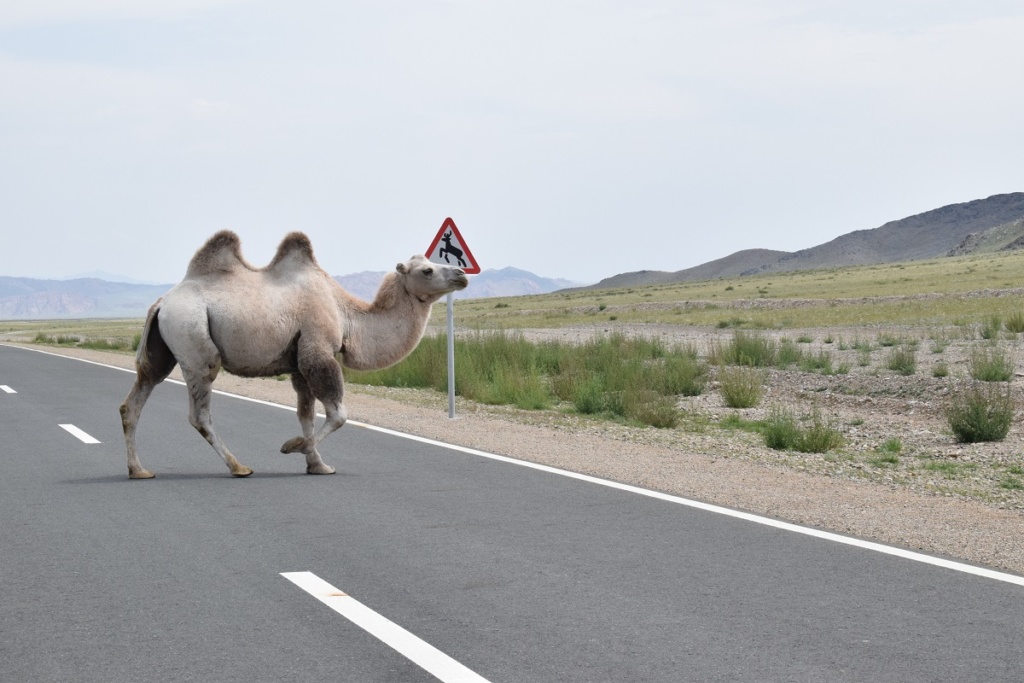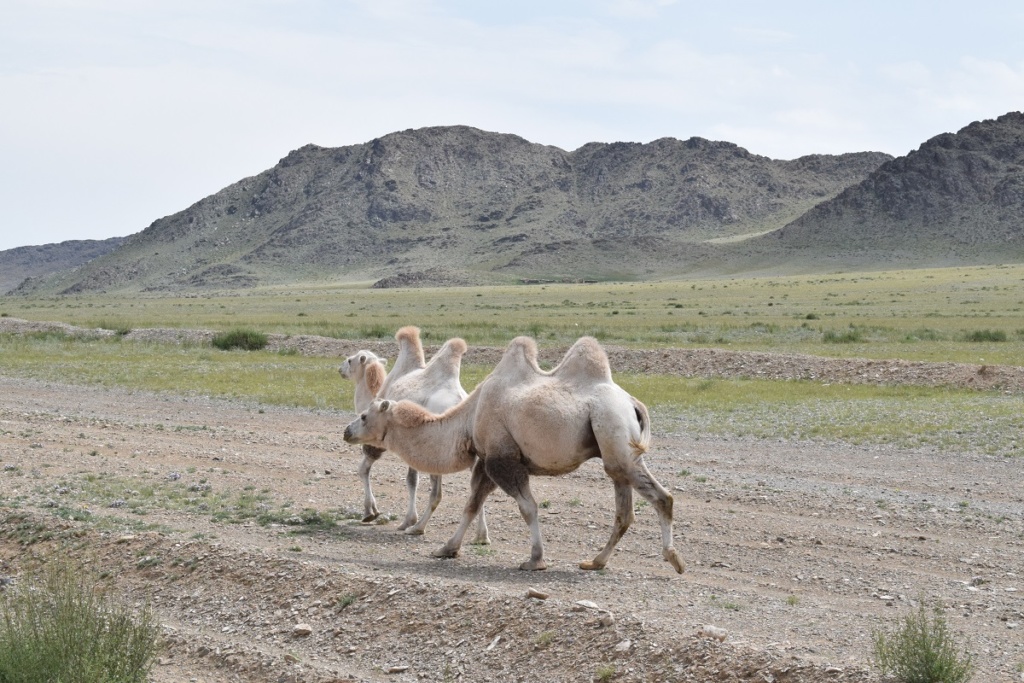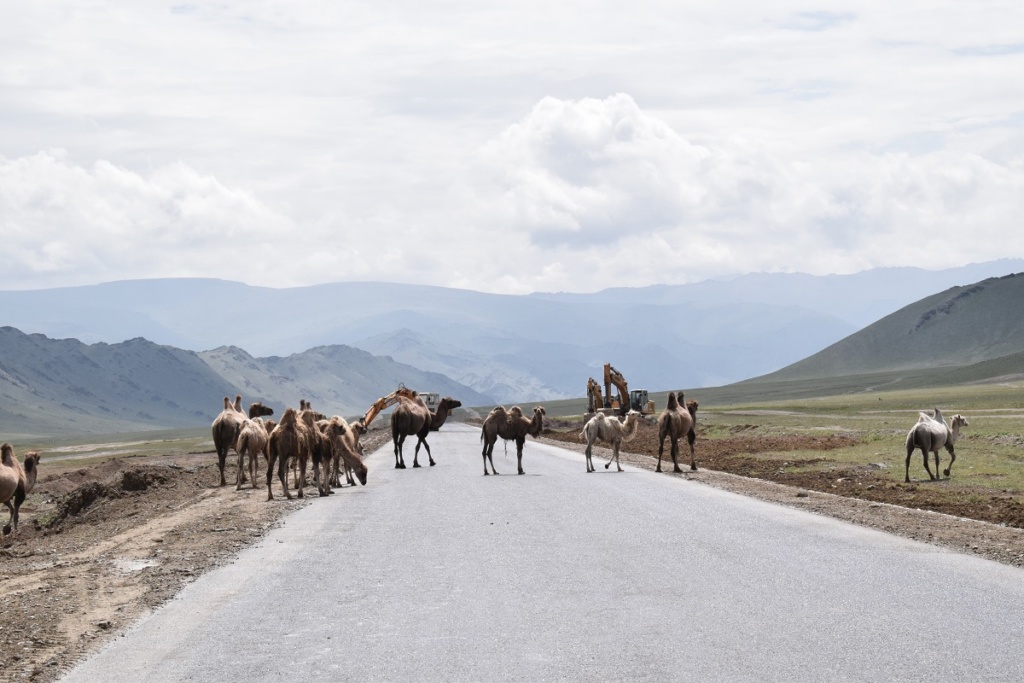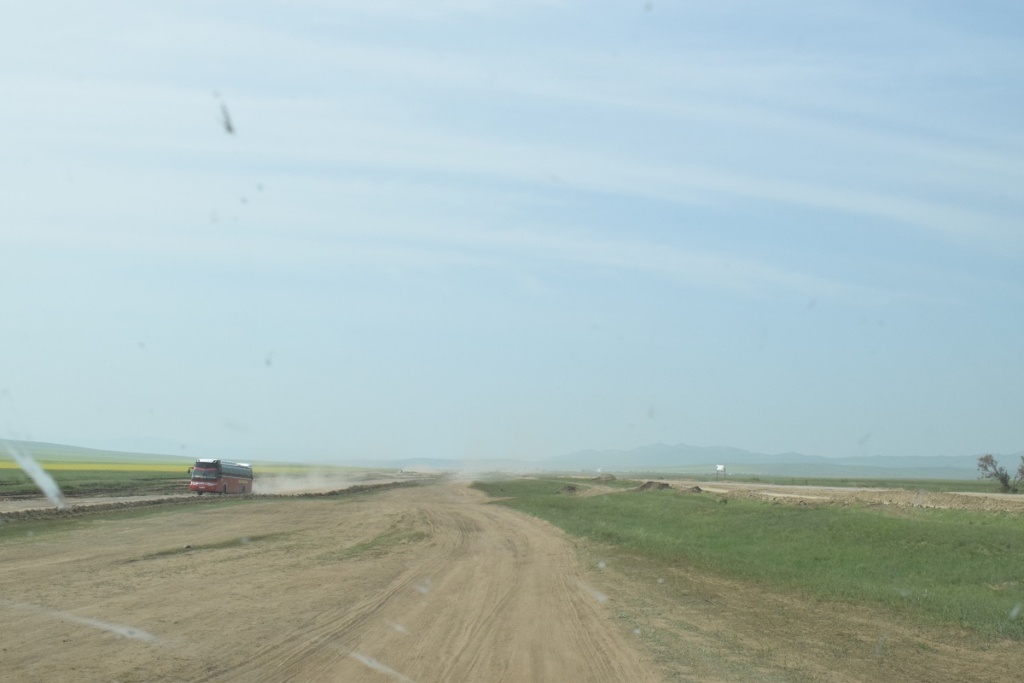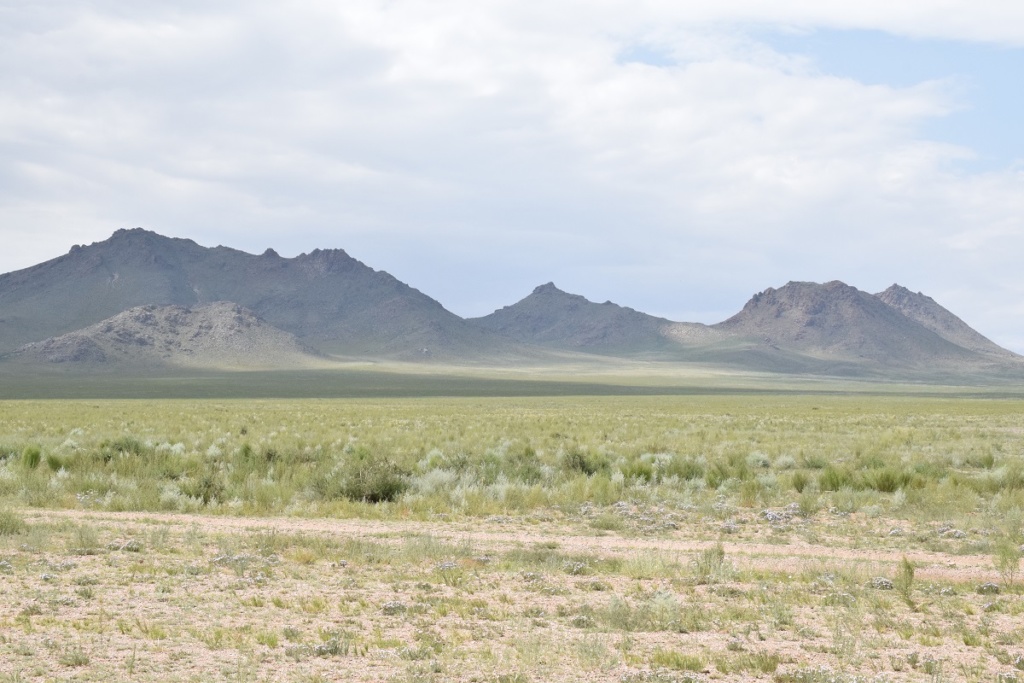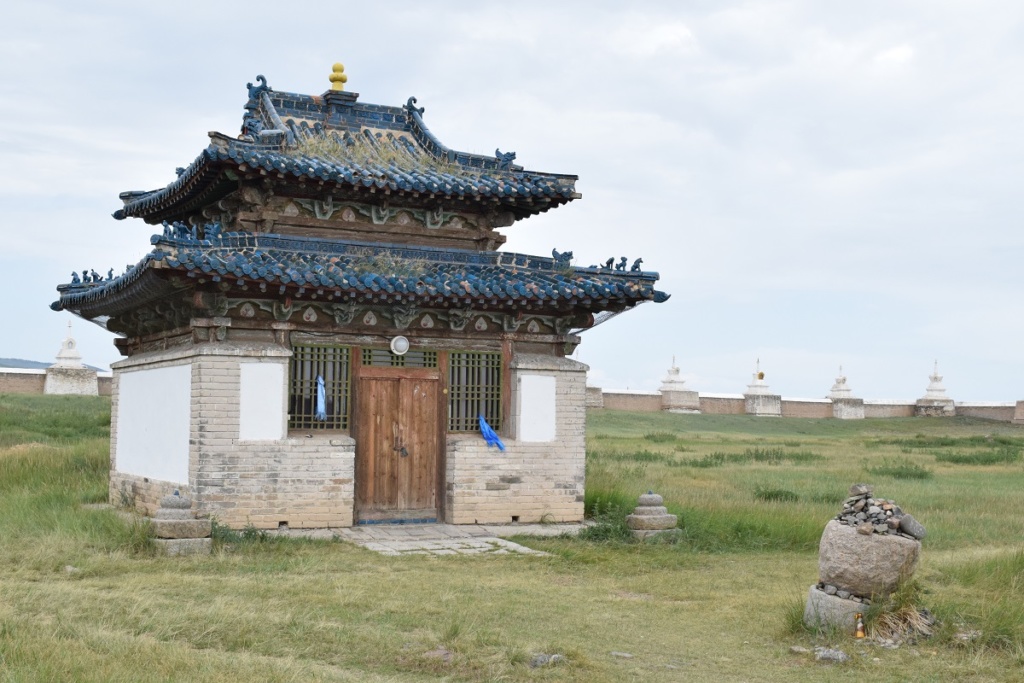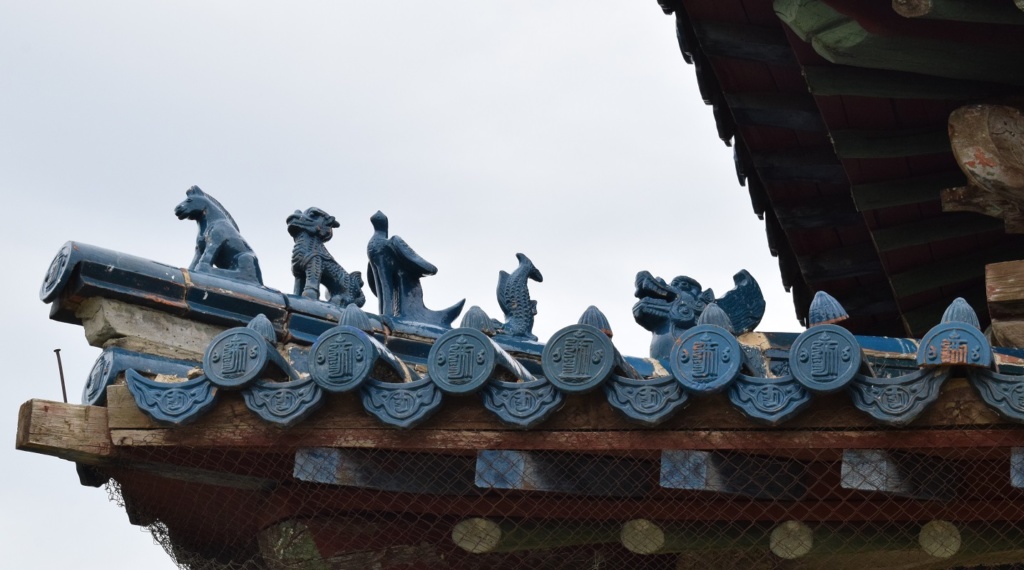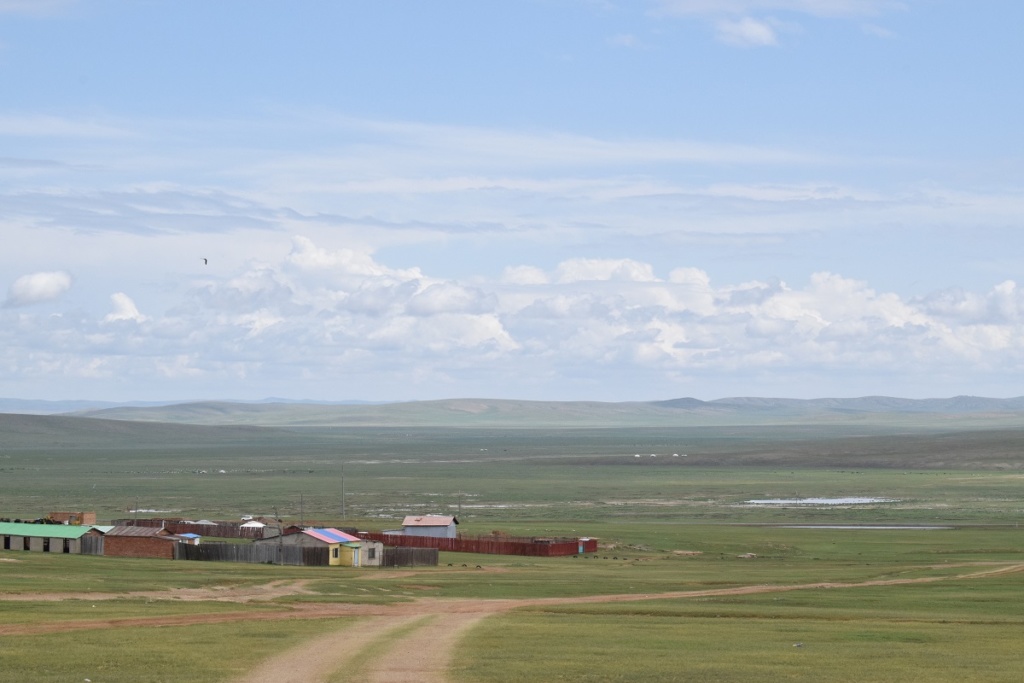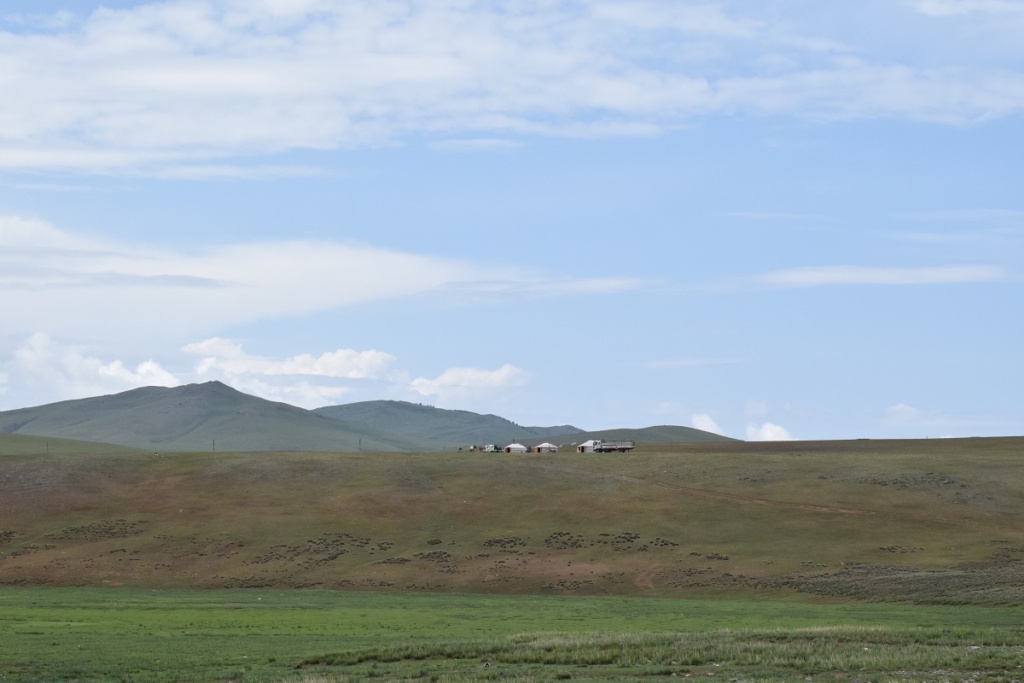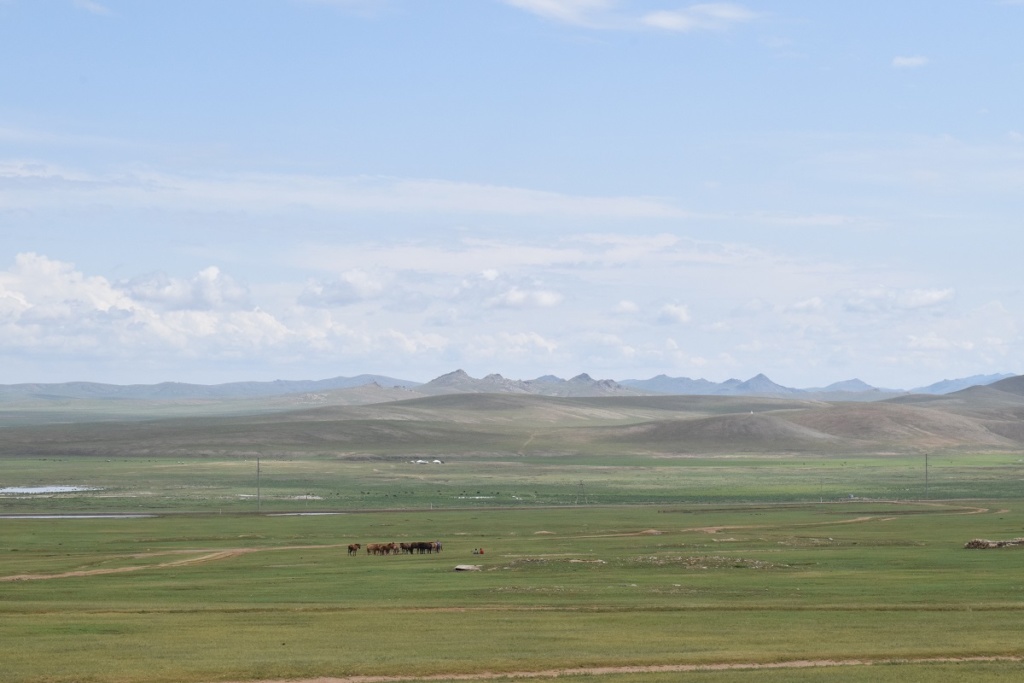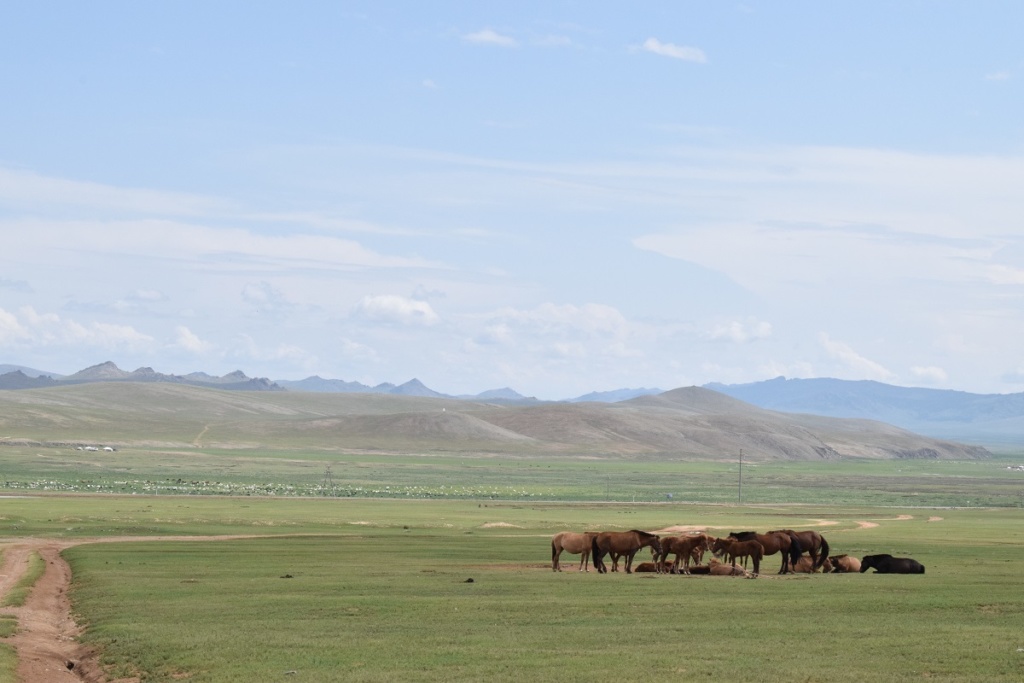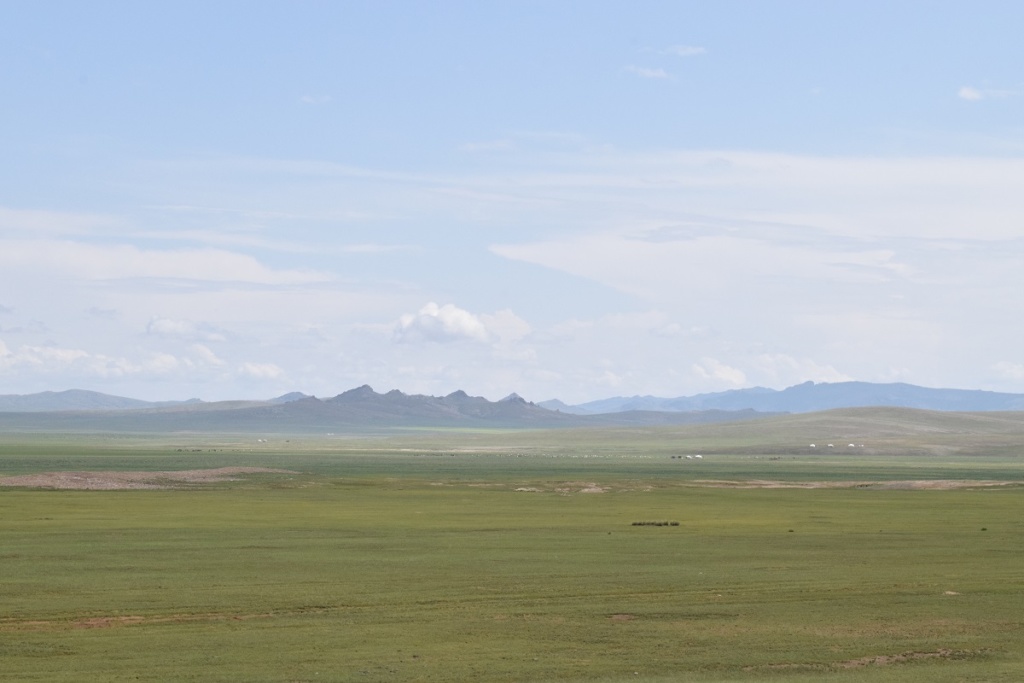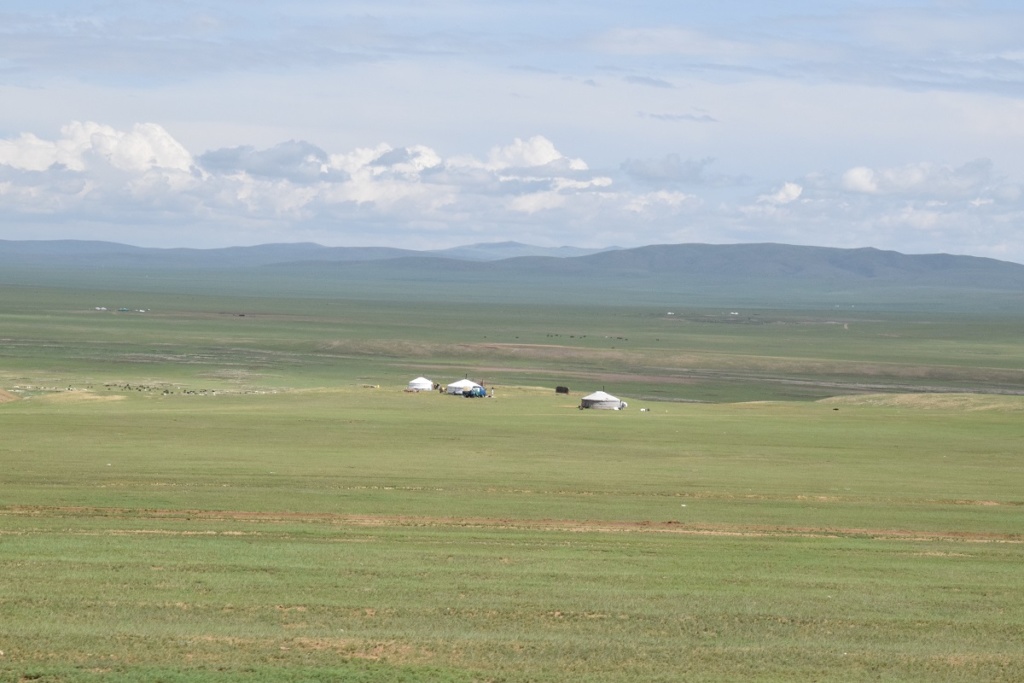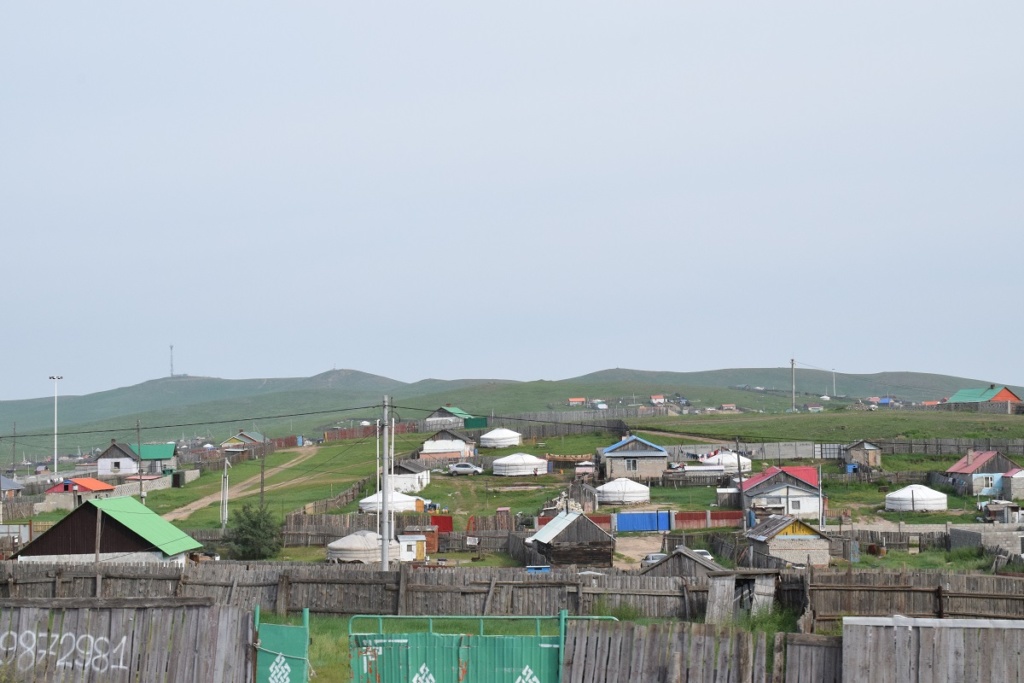Wednesday 31st July, 2019 – OLGII
There is a 26kms no man’s land between the Russian and Mongolian borders and the road is unpaved but not too bad. The border post is at the top of the Durbet-Daba pass (2,482m). The weather was overcast and we felt the chill: down to 12 C…
We then had well paved road all the way to Olgii where we stayed for the night. We saw the change in the landscape with vast plains covered in short green grass, no trees and devoid of inhabitants. Mongolia counts 3million people and half the population lives in the capital, Ulaanbaatar!
Thursday 1st August, 2019 – KHOVD – ALTAI
We continued on our way to the capital, some 1,700 kms away. Surprisingly the road is very good and we almost make it to Altai before stopping for the night . The scenery changed from green steppe to desert and the temperature is back in the 30C.
Saw our first two-humped camels. They are raised as cattle and move in packs. This is one of the dangers on the road. Animals move freely and it is not unusual to have horses, cows, sheep and camels crossing what is the equivalent of the highway or even lying on the road!
Friday 2nd August, 2019 – Bayankhongor
It was too good to be true…. the road turned to dirt road not long after Altai. Our map and Satnav were showing the main “Southern Route” ( highway) continuing all the way to Bayankhongor but the actual road was further north and was not great, i.e a collections of dirt tracks all more or less following the same direction but sometimes confusing as there might be 4 or more tracks at the same time and it is not always obvious if they will all rejoin eventually.
As we found out repeatedly over the next few days, the main road is under major repair and it is shut to traffic for long stretches. In this case, temporary roads are created by cars and lorries going over the “fields”. The tracks quickly deteriorate and new ones are created by cars avoiding the potholes, puddles and the likes. You end up with situations where you can have 3 or 4 cars passing each other in different directions and all at the same time, all this in a huge cloud of dust where you can barely see the ground…. After more than 150km of bumpy road, we finally rejoined the asphalted road, not long before Bayankhongor.
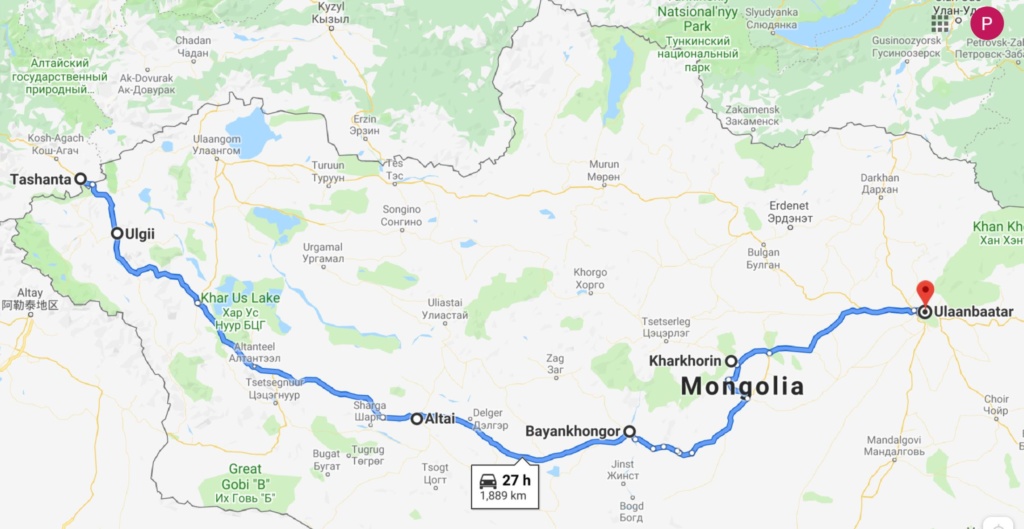
Saturday 3rd August, 2019 – KHARKHORIN
Thankfully, the road is mostly paved today and we arrive late afternoon. The weather though is not so good so we decide not to camp today and find a hotel not far from the main attraction in Kharkhorin: the Erdene Zuu Complex ( Buddhist monastery).
Geographically, Kharkhorin is more or less at the centre of Mongolia. Nearby are the ruins of the ancient town of Karakorum (also known as Kharkhorum or Qara Qorum) which, for a short time (early 13th century), served as the capital of the Mongol empire under Ogedei Khan (third son of Genghis Khan). Important archeological finds were made in the region, notably a tomb dating from the 6th century where pottery and gold trinkets were burried and you can learn all about the Mongol Empire at the Town museum which is small but has numerous artefacts, all well displayed and labelled in english.
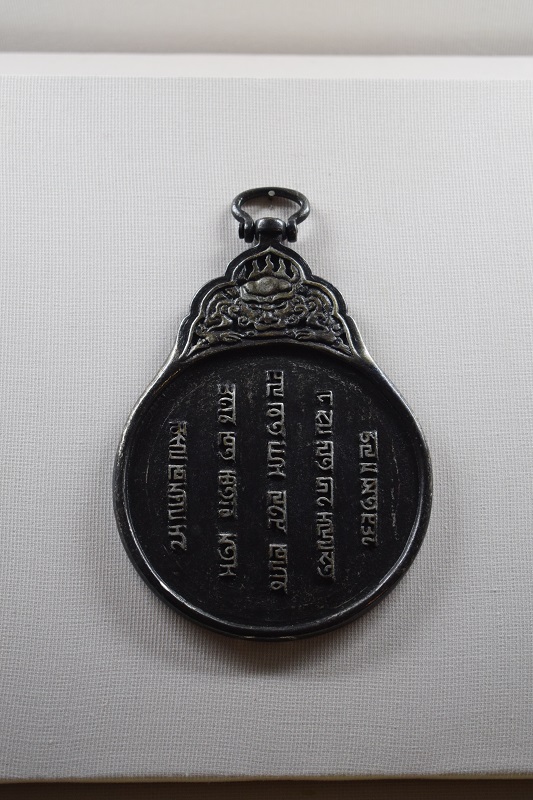

Sunday 4th August, 2019 – Kharkhorin – Shankh
The main attraction of the town though are the remains of the 16th-century monastery, Erdene Zuu Khiid which offer some evocative insights into the region’s golden era .
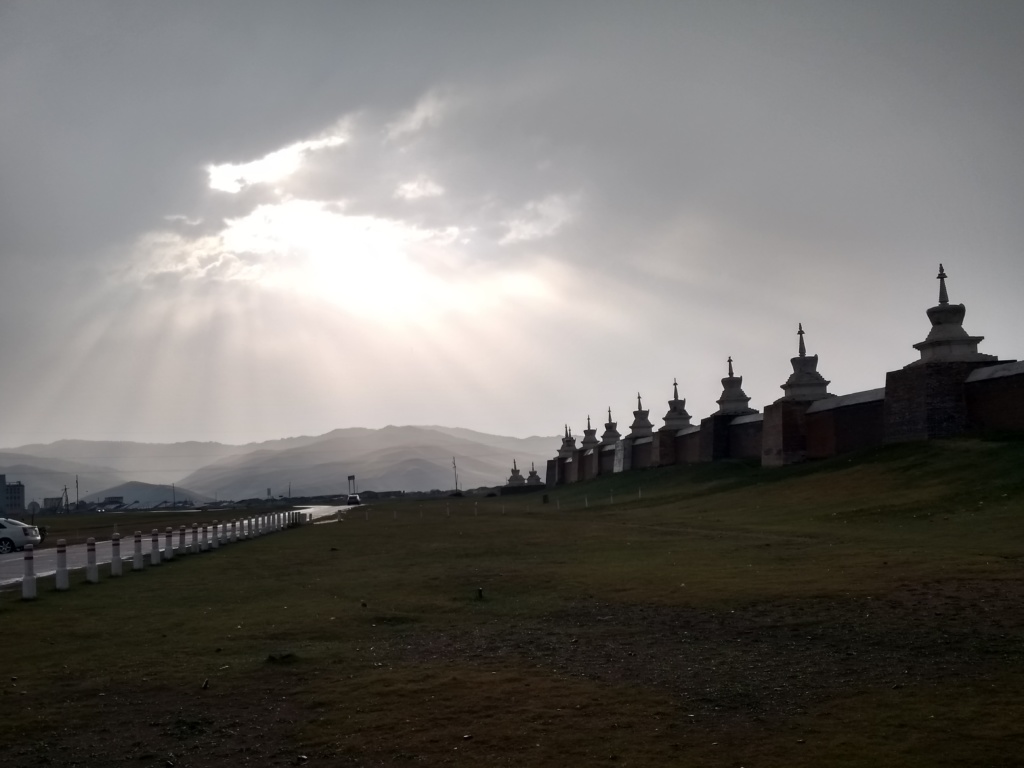
Founded in 1586 by Altai Khaan, Erdene Zuu (Hundred Treasures) was the first Buddhist monastery in Mongolia. The monastery went through periods of neglect and prosperity until finally the Stalinist purges of 1937 put it completely out of business. Religious freedom was only restored after the fall of Communism in 1990 and the monastery became active again . Today Erdene Zuu Khiid is considered by many to be the most important monastery in the country, though no doubt it’s a shadow of what it once was. At its peak, it had between 60 and 100 temples, around 300 gers inside the walls, and up to 1000 monks in residence. All but three of the temples in Erdene Zuu were destroyed during the purges and an unknown number of monks were either killed or sent to Siberian gulags.
The monastery is enclosed in an immense walled compound. Spaced evenly along each wall, about every 15m, are 108 stupas (108 is a sacred number to Buddhists).
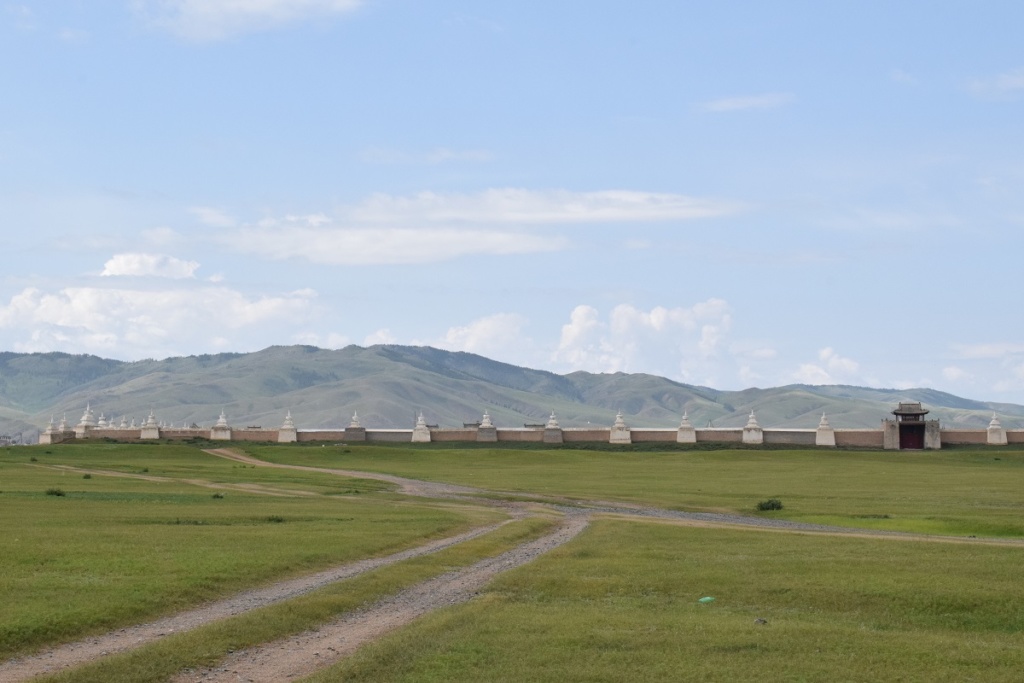
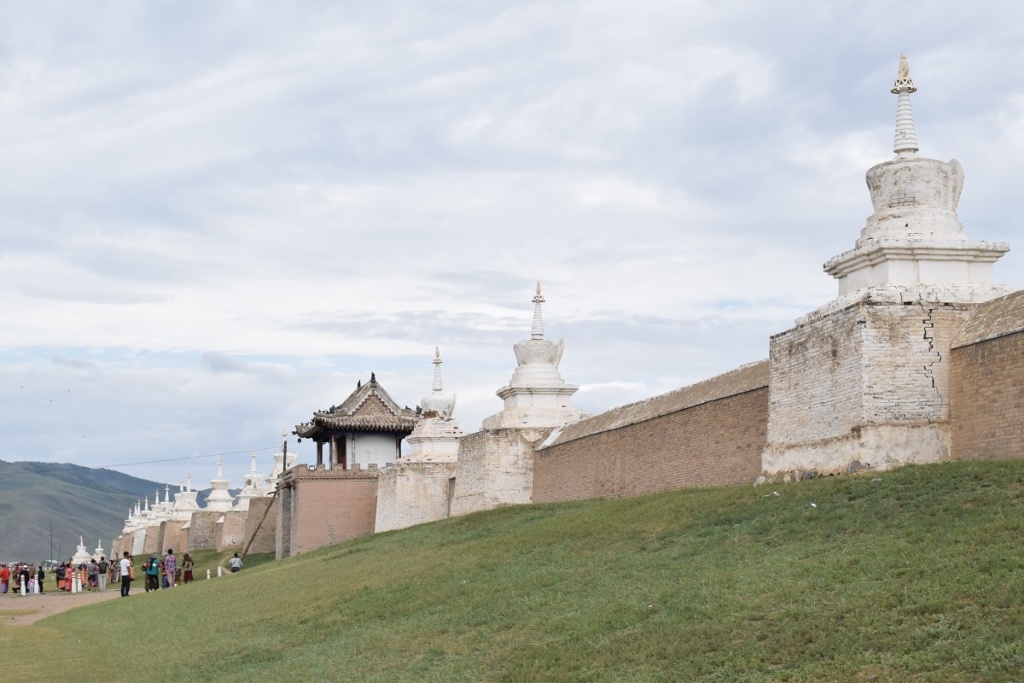
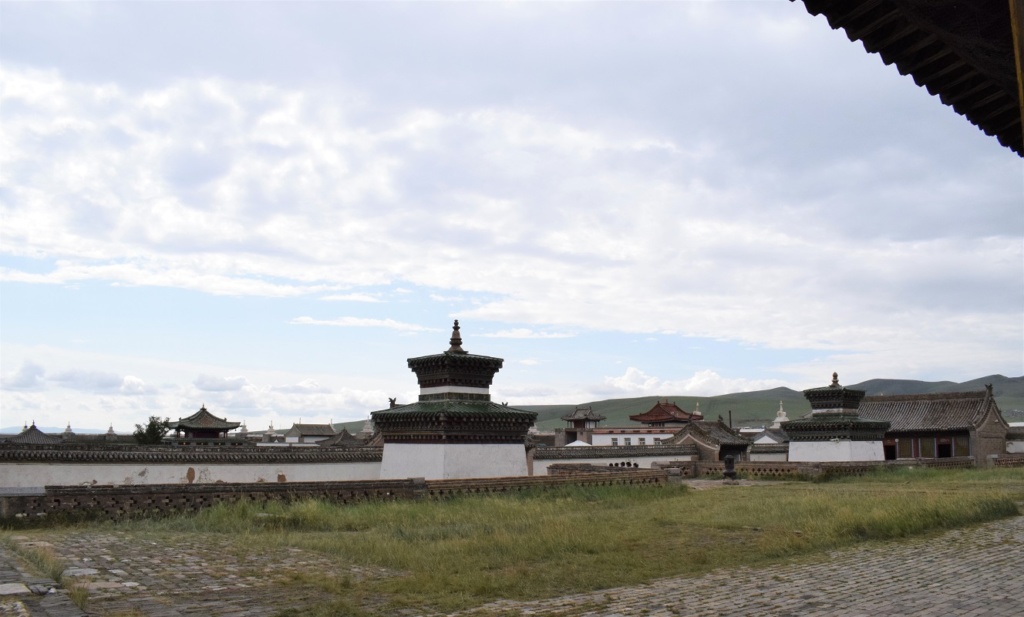
Inside the compound
The three temples in the compound – Zuu of Buddha, Zuun Zuu and Baruun Zuu – which were not destroyed in the 1930s, are dedicated to the three stages of Buddha’s life: childhood, adolescence and adulthood.
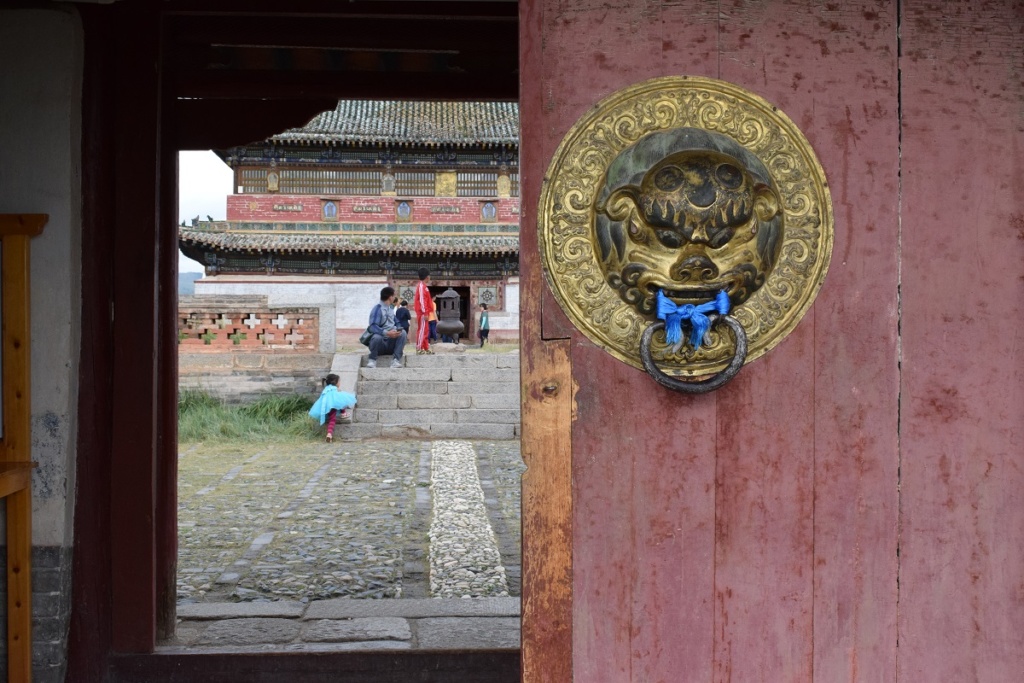
Inside each temple are a number of statues and masks, mainly from the 18th century.
These balin (wheat dough cakes, decorated with coloured medallions of goat or mutton fat), made in 1965 (when the Monastery first re-opened but could not run as a religious centre) are still well preserved .
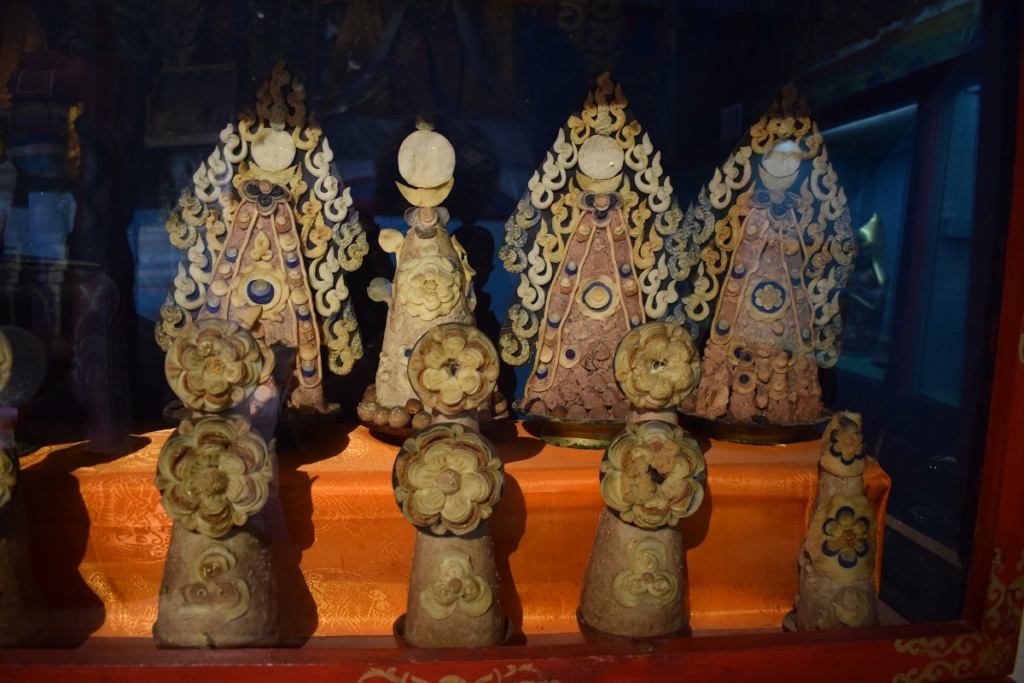
Ceremonies are held every morning by resident monks in a white tibetan temple “Lavrin Sum”and visitors are welcome to attend (no photos inside).
This small temple can also be found in the monastery complex.
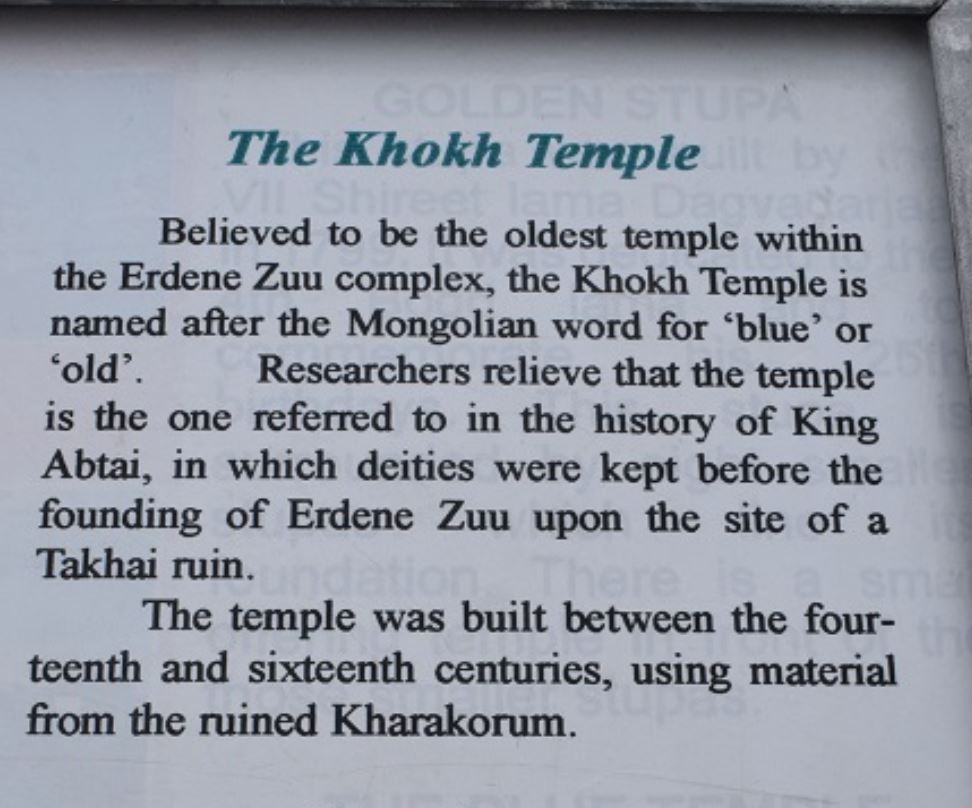
Although some religious fervour is shown by visitors, the site is on the tourists ” to do” list and inevitably you have a number of shops just outside the compound selling all kind of cheap souvenirs. One of the favorite activities for locals seems to be dressing up in old traditional clothes and have their picture taken.
Shankh Monastery
We leave Kharkhorin early afternoon but stop on the way at the Shankh Monastery, 25km away. The Shakh Monastery is one of the oldest and most important monasteries of Mongolia. It was founded in 1647 by Zanabazar who was the first Tibetan Buddhism’s religious leader. The monastery belongs to the Yellow Hat Sect, “Gelugpa”, which is a school of Tibetan Buddhism. Its main temple is famous for its seven Kalachakras mandalas that represent the 722 Kalachakra divinities, absolutely unique in Mongolia.
In the 1920’s it was composed of about twenty edifices and housed more than 1500 lamas but greatly suffered from the violent Stalinist purges in 1937 and only the main temple survived. Fortunately, most of the precious religious relics of the monastery had been removed and hid by one of the novices and thus, survived the destruction.
Scenery on the way to the Monastery and further along the road.
Monday 5th August, 2019 – ULAANBAATAR
Arrived in Ulaanbaatar midday. It has been raining since yesterday and the streets are disappearing under large puddles. There does not seem to be any drains or they cannot cope and the water has nowhere to go. The pavements ( when there are any) are a sea of mud, especially in the back streets.
We check in the flat we booked only to find out that there is no hot water. This is a common occurence in summer in Russia and former Soviet Republics as this is the time when the annual overhaul of the heating system is carried out and hot water is turned off for whole blocks at a time. This can last for days. Our host is very apologetic. The temporary electric shower system she had in place has broken down but she agrees to provide a new one and true to her words, she comes round in the evening and install a new one. She even brings us a welcome bag of groceries and we have a nice chat. ( Thank you Tuul !)
Tuesday 6th August, 2019 – ULAANBAATAR
The flat is near the Gandantegchinleng Monastery ( translates roughly as ‘the great place of complete joy’) and we stop there on the way to the centre.
Built in 1838, today it remains an important religious centre for the whole country with a Mongolian Buddhist University (established in 1970); three colleges of Buddhist philosophy; a Medical and Astrological College and several temples. More than 600 monks are in residence and the university attracts students from abroad.
The main attraction of the site is the white Migjid Janraisig Süm and the Migjid Janraisig statue.
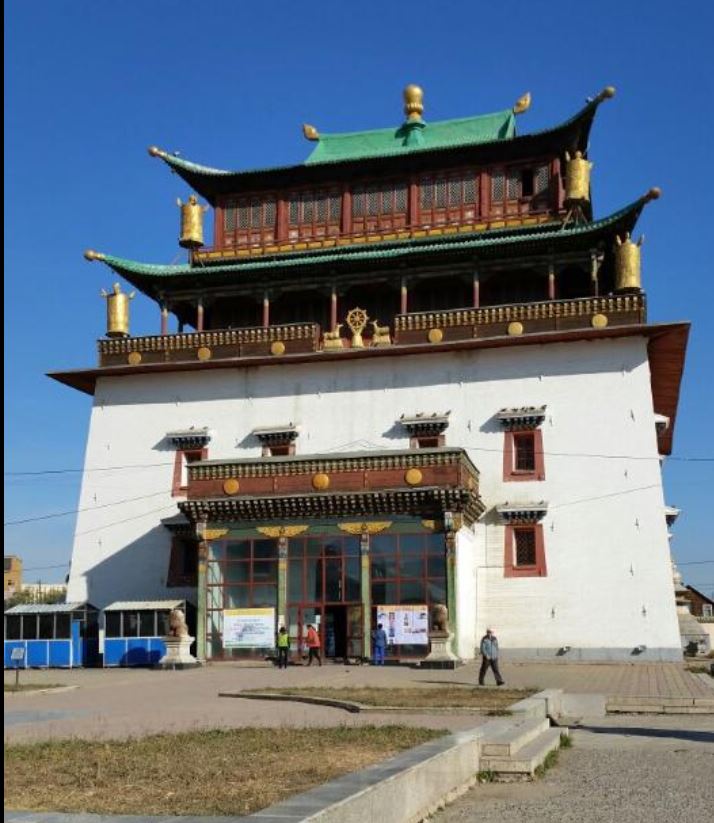
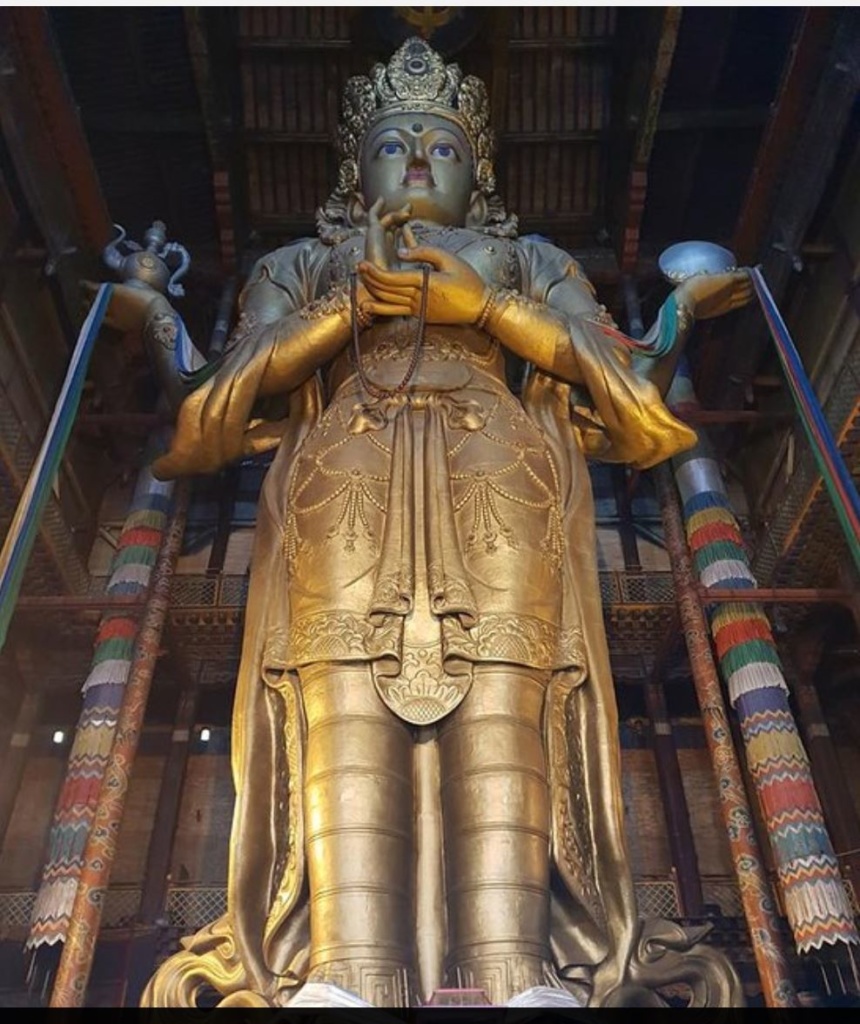
It is 26m high and made of copper with a gilt gold covering. The hollow statue contains 27 tonnes of medicinal herbs, 334 Sutras, two million bundles of mantras, plus an entire ger with furniture!
Ulaanbaatar is a cosmopolitan city with a mix of modern and old, businessmen in expensive suits run along nomads just arrived from the steppes. One minute you are in a whirlwind of traffic and bustling activity and the next in the peaceful surrounding of the grounds of a temple listening to chanting Bhuddist monks.
The temples which survived the purges of the 1930’s are now lost among skyscrappers.
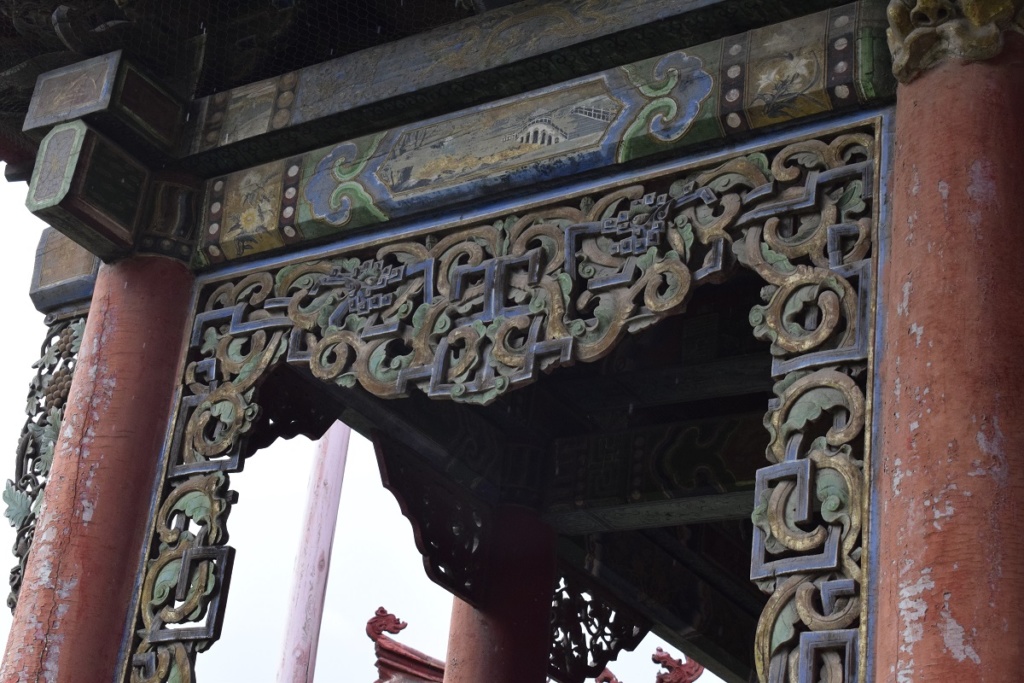
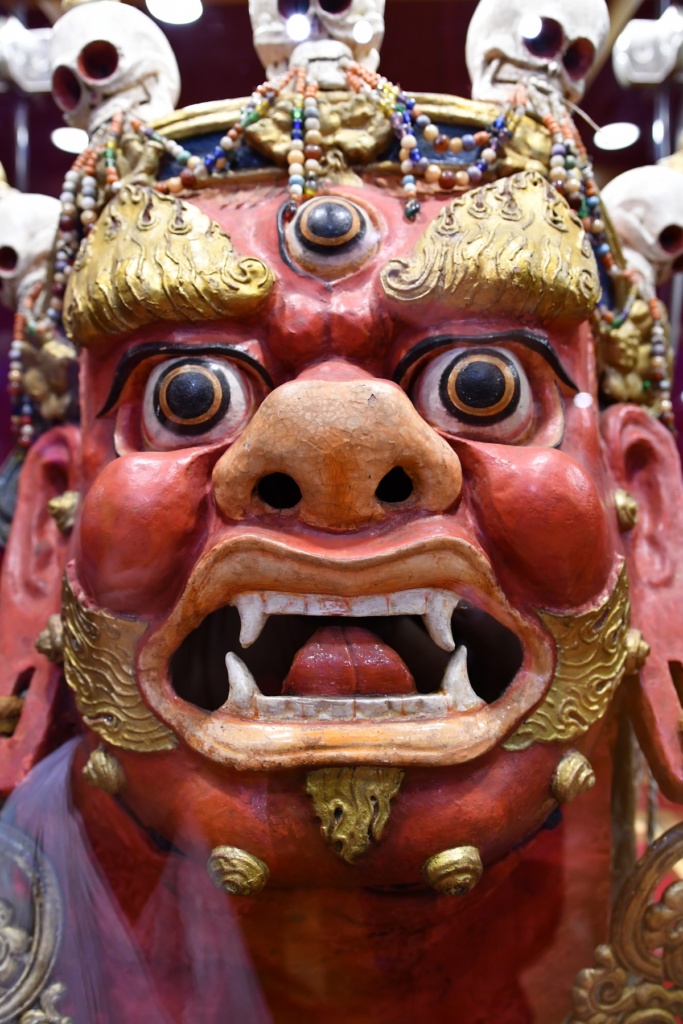
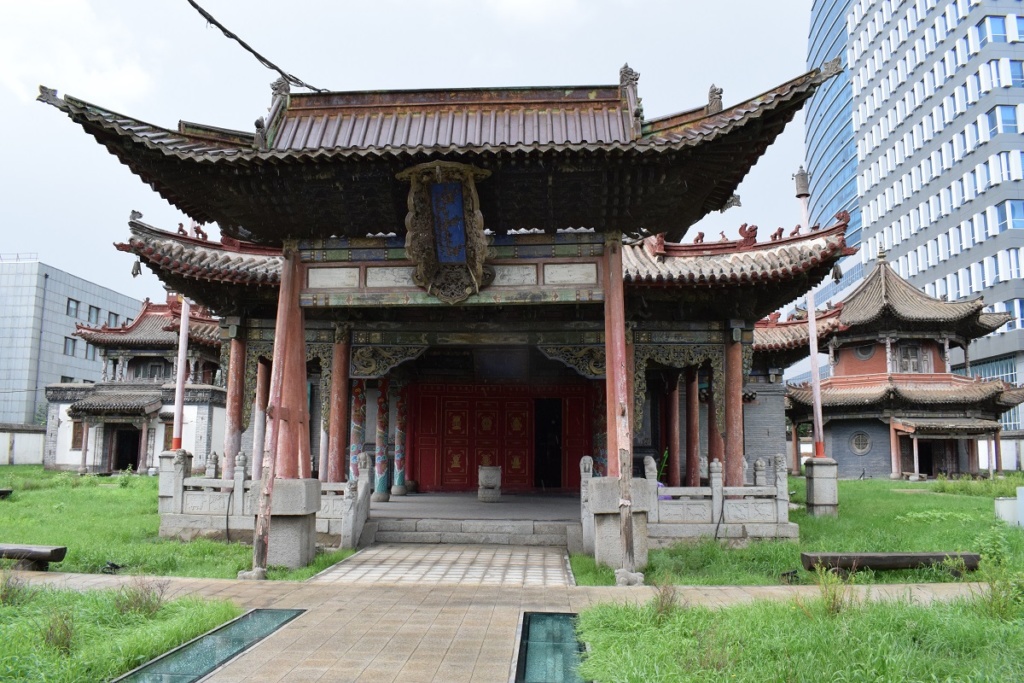
Choijin Lama Museum
Wednesday 7th August, 2019 – ULAANBAATAR – Tsonjin Boldog
We went for a day excursion to the Ghengis Khan (Chinggis Khan in mongolian) statue.
In 2008, a gigantic statue of Genghis Khan riding on horseback was erected on the bank of the Tuul River at Tsonjin Boldog, 54 km east of the Mongolian capital Ulaanbaatar, where according to legend, he found a golden whip.
The statue is 40 meters tall and wrapped in 250 tons of gleaming stainless steel. It stands on top of the Genghis Khan Statue Complex, a visitor center that itself is 10 meters tall, with 36 columns representing the 36 khans from Genghis to Ligdan Khan. The statue is symbolically pointed east towards his birthplace.
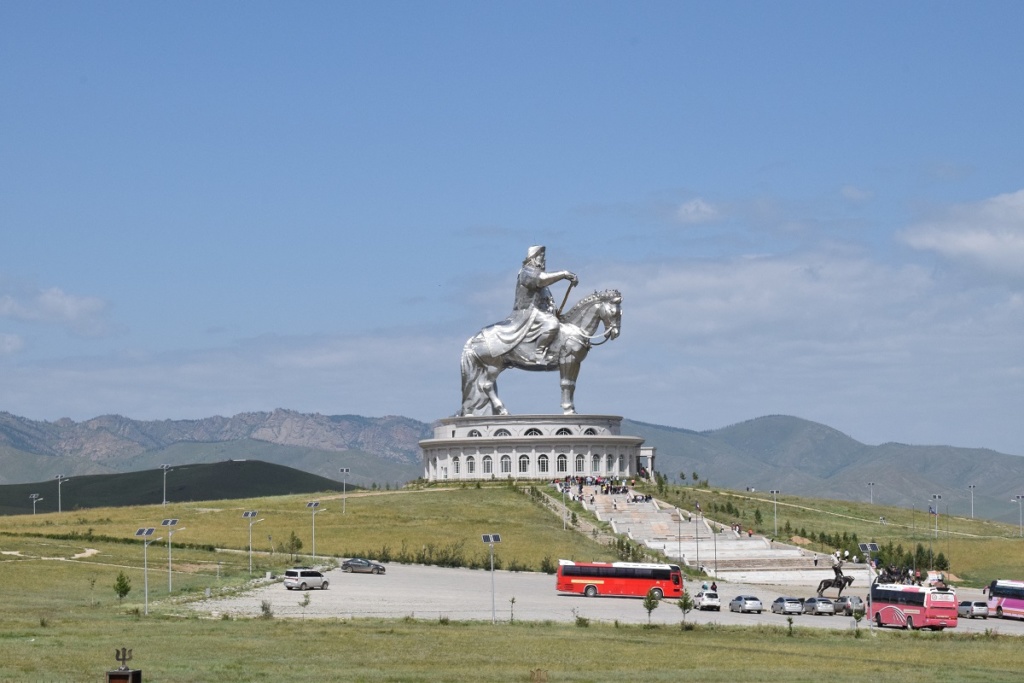
The Chinggis Khan Statue is currently the biggest equestrian statue in the world.
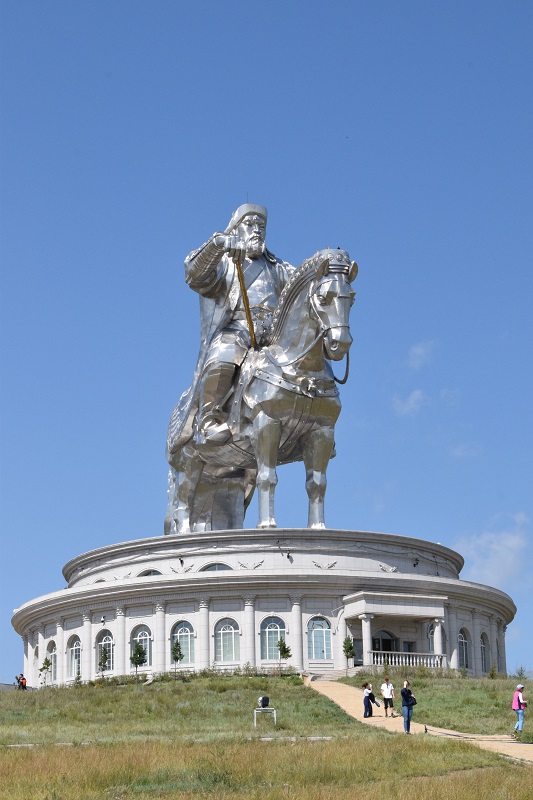
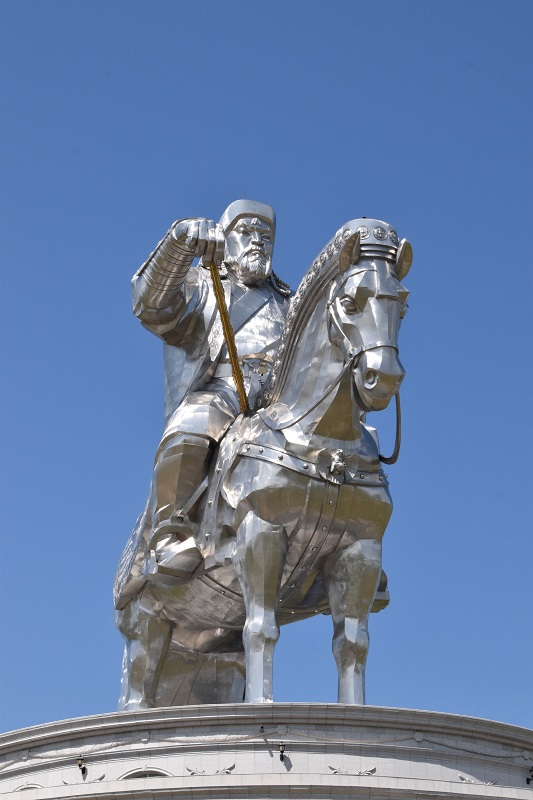
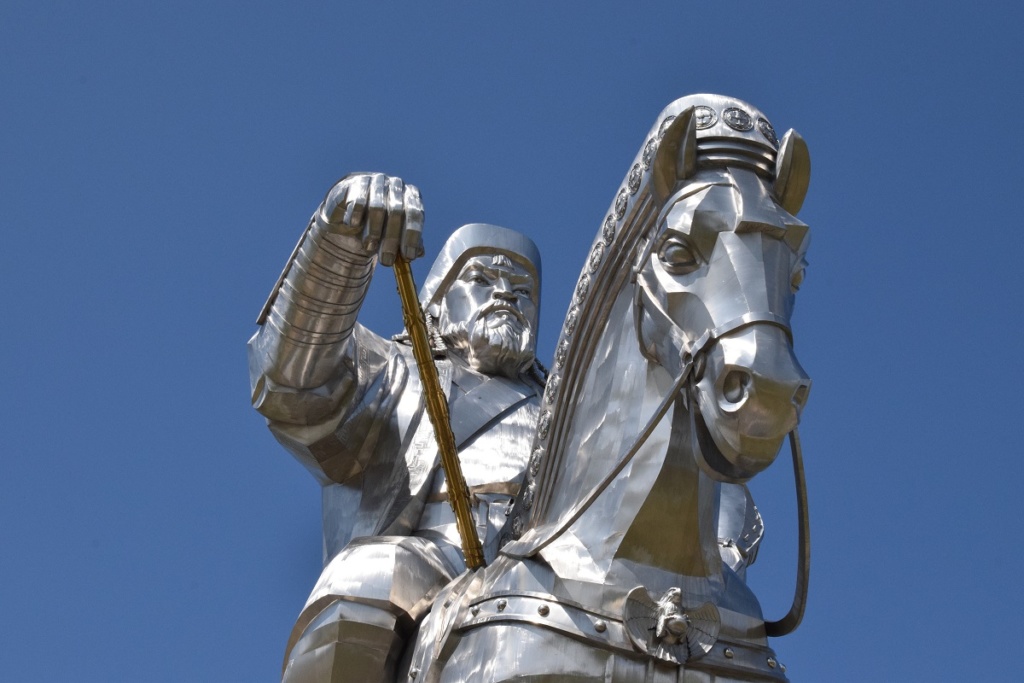
Ghengis Khan
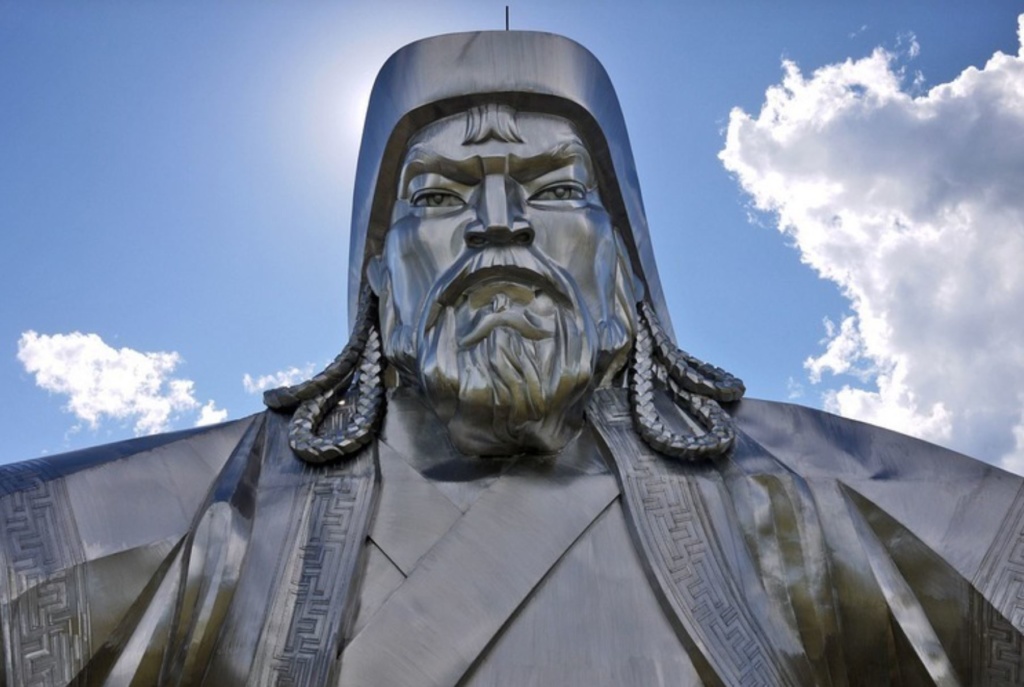
On the way back to Ulaanbaatar we made a detour to the Gorkhi-Terelj National Park to see some interesting rock formations. The park is a popular destination due to its proximity to the capital and we found it too touristic for us with too many yurt camps and resorts.
We made our way back to UB and visited the Bogd Khan Museum. This was the winter palace built between 1893 and 1903, where Mongolia’s eighth Living Buddha, and last king, Jebtzun Damba Hutagt VIII (often called the Bogd Khan), lived for 20 years, until his death in 1924.
There are six temples in the grounds; each now contains Buddhist artworks , notably some statues by Zanabazar ( 17th century) known for his intricate and elegant Buddhist sculptures .
The Palace itself is a white Western-looking building where Mongolia’s Declaration of Independence (from China in 1911) and a collection of gifts received from foreign dignitaries, such as a pair of golden boots from a Russian tsar, a robe made from 80 unfortunate foxes and a ger lined with the skins of 150 leopards are among the exhibits.
Thursday 8th August, 2019 – Khyagt – Russian border
We leave Ulaanbaatar, going through the suburbs where gers are frequently the only structure on individual plots of land: a sign that the Mongolians are still very attached to their ancestral nomad origins and prefer a ger to a house.
The intention today was to drive as close to the border as possible and cross tomorrow but in the end we arrive at the border at 6pm and decide to cross. There is a long line of buses and lorries but not so many cars. We have to wait for a while before being allowed in the border compound. Once inside, it is the usual running around from passport control to customs offices and car search: total 3 hours. It is getting dark but we carry on. It is now too late to set up camp and we end up in a small industrial town called Gusinoozyorsk where we find an old soviet style hotel.
